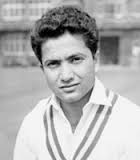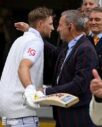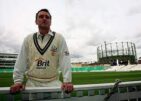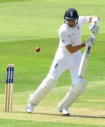Hanif Mohammad: Pakistan’s original “Little Master”
Gareth Bland |
On 21st December one of the greatest batsmen in the history of the game turned 80. Hanif Mohammad, as resilient in the face of cancer as he was indefatigable at the crease, achieved the landmark surrounded by family, friends and some of Pakistan’s current crop of players. Reserving his celebrations for the twenty-third, Hanif waited the extra two days in the event that Pakistan’s chairman of selectors Shaharyar Khan – in Karachi on other business – should drop by and acknowledge his nation’s finest willow-wielding son. The chairman’s non-appearance was yet another snub from Pakistani cricket officialdom toward this most genteel of men.
Hanif Mohammad was born in Junagadh in Gujarat, India in 1934, scion of a notable cricketing family. Although brothers Wazir and Raees are perhaps less well known, two more siblings went on to represent Pakistan with the greatest distinction. Having entered Test cricket himself in 1952, Hanif was followed into the international arena by brothers Mushtaq and then Sadiq. Mushtaq, leg-spinning all-rounder and future captain, and Sadiq, punchy left-hand opening partner of Majid Khan, are names redolent of the glamorous but unfulfilled 1960s and 1970s, in the days before Imran Khan dissected his country’s game and recalibrated it for the 1980s and beyond. Hanif, however, is a name synonymous with the young nation entering Test cricket following Partition. Just thirteen when that seismic event of nation building took place, Hanif was representing the newly founded Pakistan by the time he was 18.
He is, of course, an iconic figure for two innings above all others. At the age of 22, touring the Caribbean for the first time, he stunned the West Indian bowlers into a state of total enervation. With an impeccable defence and with adept mastery of the short ball, Hanif batted 16 hours and 10 minutes for his 337. Even now it is an incredible feat of endurance to comprehend. Perhaps still more remarkable is the statistic of just 24 boundaries in that marathon rearguard action. Following on with a deficit of 473, Hanif blunted the home side’s attack to achieve the draw.
To top an innings like that requires something special, of course. For his next trick Hanif waited a year until the January of 1959. In the Quaid-e-Azam trophy semi-final of that year, Hanif’s Karachi were paired against Bahawalpur. The visitors were bowled out just before Tea on the opening day when an in-form Hanif paced to the middle to take guard for Karachi. Nearing the close of play on the third day, following a day of rest, Hanif set off in search of two runs which, he thought, would leave him with one more delivery to push for another two.
That extra couple would, Hanif calculated, take him to an unprecedented 500. Sadly, the scoreboard was wrong, Hanif was left high and dry going for a second run and he was dismissed for 499, not the 497 the scoreboard had led him to believe. In the process he had broken Bradman’s existing record of 452, an innings which would stand as the highest first-class score until broken by Brian Lara in 1994.
National and international acclaim followed, along with a telegram of congratulations from Bradman himself. Having being massaged with olive oil prior to the rest day, Hanif has always made light of his mammoth feats of mental and physical resolve. As he recalls:
“Concentration had never been a problem – it came naturally. I played only one lofted shot in the innings, a straight drive for four – and I broke Bradman’s record with an on-driven boundary, a small, appreciative crowd there to cheer it”
He departed the Test scene in 1969, just short of his 35th birthday. First-class cricket had not seen the last of him, though, as he continued to perform in the Pakistani domestic game until 1976 when he was 42. His 55 Tests brought him 3915 runs at 43.98, with twelve centuries. In the first-class game the little master compiled 55 centuries and 66 fifties at an overall average of 52.32. His recent years have been troubled ones as his battles with liver cancer have sapped much of that legendary fortitude. On he goes though, past 80, the Grand Old Man of Pakistani cricket.
Hanif’s health problems have been exacerbated by the seeming indifference of the Pakistani Cricket Board towards his illness. Following surgery in 2011 in London, Hanif later spoke out in 2013, following his 79th birthday. Convalescing at home, he remarked:
“The Pakistan Cricket Board (PCB) didn’t bother to inquire from me about how I was managing things and this is very painful. I have come to the conclusion that there is no respect or care for sportsmen once he retires in our country and this is very painful for me”
His tale seems the all too familiar one of the retired sportsman. Having retired from the game when he could not possibly have imagined the sums being earned nowadays, Hanif – a genuine great of the game – has found himself in a position of increasing penury. It was after Hanif spoke out on his 79th birthday that cricket fan and Pakistan’s Prime Minister Nawaz Sharif informed him that help would be on its way. Hanif, having run up medical bills of some seven million Rupees, received assurance from Nawaz that the PCB and the Pakistani Sports Board would examine his case.
Hanif has good cause to feel slighted on the cricketing front, too. A trailblazer for the game in his country, he has yet to receive official recognition from the Pakistani Board for his Test triple century scored back in 1958. As he observes:
“The PCB has recognised and rewarded Inzamam and Younus for scoring triple hundreds, but my feat hasn’t been acknowledged by them to date. I played in an era where cricketing gear wasn’t appropriate and neither were the pitches. We took body blows for our country, sustained bruises and broken bones but yet our achievements have been overlooked, which is a shame.”
Whatever the PCB’s motivations, Hanif is still respected and revered by the current generation of Pakistani players. The praise of one in particular must make the old man proud. A hard-working Pathan with prodigious powers of endurance himself, Younus Khan is in no doubt as to Hanif’s status in the history of the game. Speaking at the birthday celebration of the man he calls “the legend”, Younus said:
“I’ll take upon the task myself of pleading our living legend’s cause. I will appeal to the government and the concerned authorities to not just give Hanif an academy but a proper institute should be built in his name where players can learn the trade. Today our hero is alive and we should act quickly to honour his services instead of mourning in the future. Players like Hanif are the nation’s real heroes because they played in an era where there were hardly any facilities as compared to today”
In his two cricketing autobiographies Imran Khan issued praise only sparingly when it came to the batting talents of his compatriots. Only Asif Iqbal, Javed Miandad and his own cousin Majid received qualified praise. Moving across the border to India, it was a diminutive son of Mumbai, Sunil Gavaskar, who Imran felt was the most complete Asian batsman.
A man dubbed the Little Master in his own playing days, Gavaskar combined matchless technique, unwavering powers of concentration and the ability to attack in exhilarating style when the moment took him. Had Imran stopped to ponder, he would have realised that one of his fellow countryman was pulling off similarly legendary feats as he spent his own gilded youth in Lahore. That man, Hanif Mohammad, was Pakistan’s and the subcontinent’s original Little Master.





There’s a footnote in Wisden regarding his 337 against the West Indies; it’s listed as the longest Test innings, at 970 minutes, but adds “Hanif believes that he batted for 999 minutes.” I would be interested to know why that’s the case.
Comment by David Taylor | 4:12pm GMT 12 February 2015
Apparently, Hanif has a gramophone recording of the radio commentary at the end of his innings which said he’d batted for 999 minutes. Unless it was a genuine mistake on the part of the commentators, I can’t think where the discrepancy comes from.
Comment by Gareth Bland | 2:50pm GMT 13 February 2015
Loved reading this. History has so many greats. Nicely done.
Comment by maja | 1:32pm GMT 17 February 2015